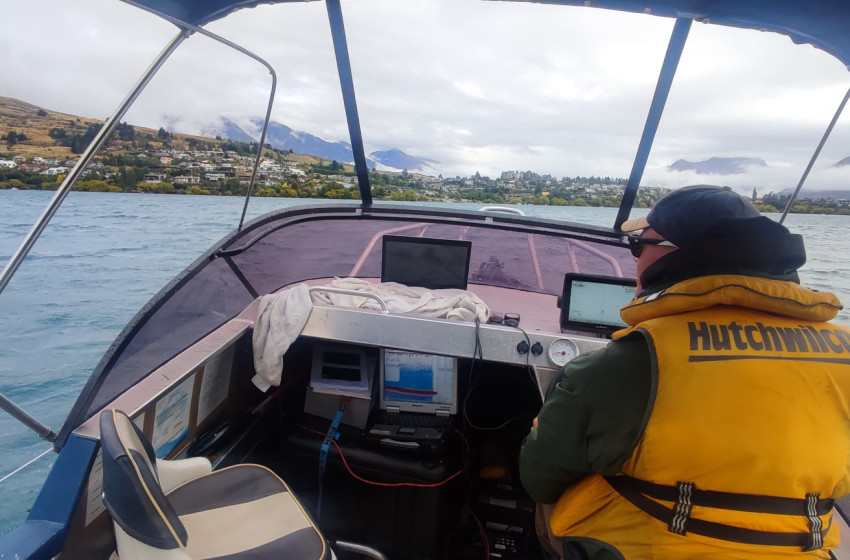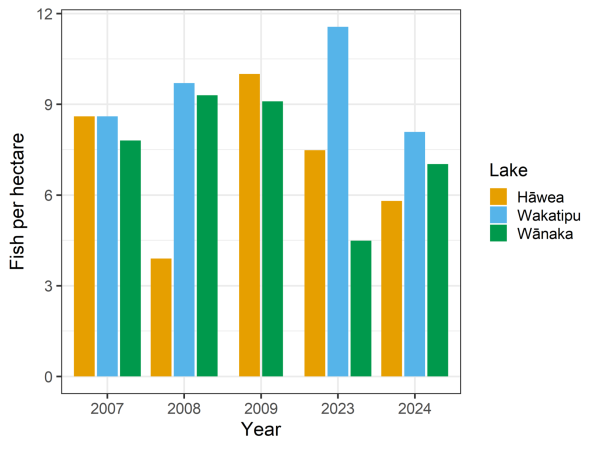Big lakes, big challenges for monitoring fish populations
- Species management Environment
- Otago
- 9/08/2024

Fish population densities in Otago's three largest lakes are relatively stable, new acoustic survey analysis suggests.
Otago Fish & Game has completed analysis for acoustic surveys of lakes Wānaka, Hāwea, and Wakatipu, which rank in the top 10 most-fished lakes in the country.
Pictured: Fish & Game officer Ben Sowry steers along precisely determined routes to measure fish population densities in the Frankton Arm of Lake Wakatipu last summer. Photo: Jayde Couper, Otago Fish & Game
“Monitoring sports fish populations in big lakes is never easy,” Fish & Game officer Jayde Couper said.
“These are big open spaces where fish can be widely dispersed.”
Mr Couper said the latest acoustic monitoring using a highly sensitive echosounder was a test of some of the more modern technology.
Data was gathered over six days last summer and followed methods established by previous surveys led by NIWA in 2007, 2008, 2009 and 2023.
It was the first survey conducted by Fish & Game staff following extensive training by expert scientists at NIWA.
“We have to find the right monitoring methods that in future will help us to manage these important fisheries,” Mr Couper said.
The acoustic surveys supplement Otago Fish & Game's other monitoring methods for the Southern Lakes and their tributaries, which include angler surveys, spawning surveys, drift dives, electric fishing, eDNA sampling, and analysis of competition catches.
In the latest analysis, Lakes Hāwea and Wakatipu showed a small decrease from last year's fish density count, while Lake Wānaka increased on a low count last year.
A Fish & Game boat navigated precisely determined routes at various sections of the lakes to scan for fish at between 3 and 30 metres of depth.
“While it's not possible to survey the entirety of each lake, previous studies have shown the areas that hold the most fish and by repeating these areas over time, we can get a picture of how lake populations are trending,” Mr Couper said.
"Fish were found mostly near the lake bottom, similar to that observed last year. That makes sense because it’s generally where the food is.”
Fish densities were relatively stable across the five surveys covering 17 years.
According to the most recent national angling survey, the three big lakes make up more than 30 per cent of angling in the Otago Region.
“The Southern Lakes are highly popular for resident and visiting anglers,” Mr Couper said.
“Fishing and recreation in our lakes contribute substantially to the economy, such the tourism, accommodation and retail sectors.
“Fishing is also being increasingly recognised for its benefits towards health and wellbeing."
A follow-up survey is planned for this summer to determine annual fluctuations and to build the long-term dataset to support management of the fishery.

Chart disclaimer: This graph illustrates fish densities at each lake over time. The survey is not designed to compare lakes, which would require randomised surveying. For example, Lake Wakatipu fish densities appear to be higher than other lakes, at least partly because the survey included Frankton Arm, a particularly productive fishery in the heart of Queenstown.